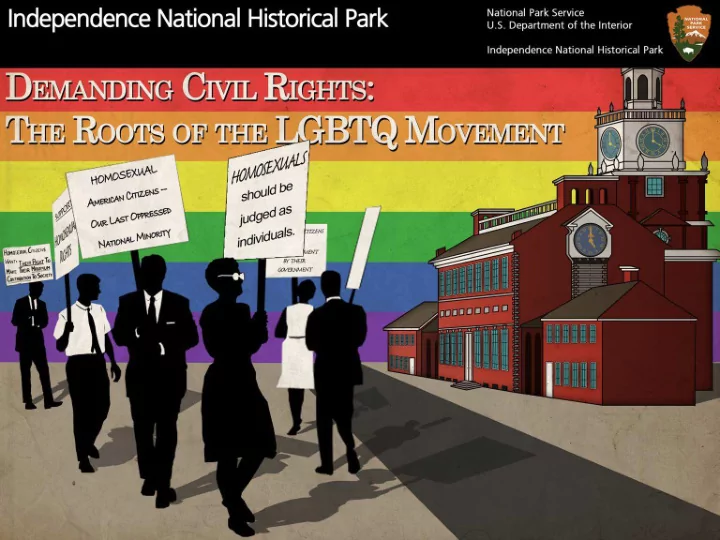

The 1950s and early 1960s were difficult times for many LGBTQ individuals. Subject to routine discrimination and harassment, many chose not to come out.
On a national level the fear of Communism grew. Coupled with the “Red Scare” there was also a “Lavender Scare” The Lavender Scare or Executive Order 10450 barred “sexual deviants” from federal government employment. Thousand of LGBT individuals lost their jobs.
In the 1950s two organizations formed to support gay and lesbian people The Mattachine Society founded in Los Angles The Daughters of Bilitis founded in San Francisco
As the Mattachine and Daughters of Bilitis grew, the organizations began setting up chapters in some of the major U.S. cities.
As the chapters spread, leadership began to form. Two East Coast leaders: Barbara Gittings Frank Kameny
Gittings and Kameny set out to protest the discrimination that they faced. They sought to take their message to the public. They wanted to protest at a location that would call attention to their plight and resonate with their cause
Independence Hall- Birthplace of the United States
They marched on the busiest day of the year- July 4 th , 1965 Around forty participants carried signs across the street from Independence Hall.
They handed out pamphlets to onlookers describing why they were protesting and framed their case in the language of the Declaration of Independence and the United States Constitution
Public reaction was mixed. They were the targets of derision, but most people simply didn’t know what to think.
Protest organizers and participants felt the event such a success that they planned to return and march on in front of Independence Hall on July 4 th every year to remind the public that they did not enjoy all the rights guaranteed to them as American citizens. They called the event the “Annual Reminder”
During this time, political unrest and activism spread across the country. The nation was in a state of change.
June 28, 1969- The Stonewall Inn Riots As the New York Police made a typical raid on a LGBT bar, patrons and the community fought back. They rioted through the early morning. This event ushered in a new era of LGBT rights.
Less than a week after the Stonewall Riots, July 4 th , 1969 marked the final Annual Reminder demonstration. Organizers decided to move the event from Philadelphia to New York in commemoration of the Stonewall Riots, it would come to be known as the Pride Parade.
Works Cited continued Lahusen, Kay. Barbara Gittings and Randy Wicker picketing. 1966. John J. Wilcox, Jr. LGBT Archives in Philadelphia Lahusen, Kay. Protesters at Independence Hall. 1965. John J. Wilcox, Jr. LGBT Archives in Philadelphia McCarthy, Joseph. Library of Congress, Washington D.C. 1954. ONE. Mattachine Soceity. John J. Wilcox, Jr. LGBT Archives in Philadelphia Ladder. Daughters of Bilitis. John J. Wilcox, Jr. LGBT Archives in Philadelphia Lahusen, Kay. Barbara Gittings 1973?-1977?. John J. Wilcox, Jr. LGBT Archives in Philadelphia Lahusen, Kay. Frank Kameny in front of Capital Building 1971. John J. Wilcox, Jr. LGBT Archives in Philadelphia Lahusen, Kay. Frank Kameny in Picket line. 1965. John J. Wilcox, Jr. LGBT Archives in Philadelphia Lahusen, Kay. Frank Kameny and fellow spokesperson talk with spectators. 1965 or 1966. John J. Wilcox, Jr. LGBT Archives in Philadelphia Lahusen, Kay. Barbara Gittings and Randy Wicker in picket line. 1966. John J. Wilcox, Jr. LGBT Archives in Philadelphia Wolfe, Frank. Vietnam War Protest in Washington D.C. Oct 21 1967 . Dav, Greg. SW-NE view of the site of the assassination of Martin Luther King, Jr. At the Lorraine Motel, site of the National Civil Rights Museum, Memphis, Tn. 2012. Davies, Diana. Stonewall Inn. 1969
National Park Service U.S. Department of the Interior
Recommend
More recommend